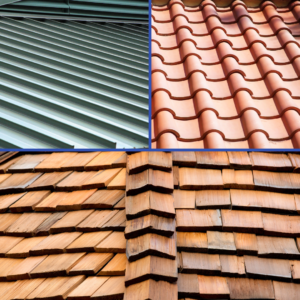Most roofs in Colorado have asphalt shingles, but your roof doesn’t have to look the same as every other house in the neighborhood. In fact, there are plenty of choices for roofing without shingles. Additionally, Colorado’s weather extremes —scorching summer sun, hammering hail, and substantial snowfall—take a toll on shingles. So, many homeowners and contractors are looking for alternative roofing materials.
What can I use instead of shingles?
Metal, wood, and tile are common shingle substitutes. In addition, there are unique options such as built-up roofs and living roofs. Or, if you’re looking for a cosmetic upgrade, you could paint the shingles. Read on to learn about five alternatives to shingles.
1. Metal Roofs
Metal roofs offer longevity and durability not seen in asphalt shingles. They are hail impact-resistant and won’t catch fire. In addition, metal roofs are eco-friendly. They reflect the sun’s rays, which reduces cooling costs. Plus, they are often made from recycled materials and can be industrially recycled after use, unlike the 11 million tons of shingle waste dumped in landfills annually. Finally, if you’re concerned about curb appeal, stone-coated metal tiles have the strength of steel with the look and feel of more traditional materials.
2. Tile Roofs
Slate, concrete, or clay tile roofs are strong and durable, withstanding hail, wind, and frost. The water-resistant properties of tile roofs mean they hold up well in Colorado’s freeze-thaw cycle. Plus, they hardly ever experience leaks, mold, or rot. Well-maintained tile can last for 100 years, making it the longest-lasting roof material in Colorado.
4. Cedar Shakes
Natural cedar shakes are thick cut from high-quality lumber, giving roofs a beautiful, rustic appeal. However, some homeowners find the high upkeep requirements can be a burden. For example, wood is prone to algae and is not naturally fire-resistant. As a result, some homeowners choose synthetic shakes made from a composite of cedar shavings, used tires, and post-consumer plastics.
5. Built-up Roofs
Contractors have used the built-up system on flat or low-slope roofs for over 100 years. Often seen in commercial buildings, these tar and gravel roofs create a continuous sealed surface with layers of asphalt and supporting fabric. As a result, they offer low maintenance, long-term durability, and fire protection. In addition, the layered nature means the roof is well protected against water and weather.
6. Living “green” roofs
As part of the green cities movement, living roofs are vegetation grown on top of buildings. This growing trend helps urban areas adapt to climate change by reducing the “heat island” effect and mitigating air pollution. Living roofs start with a waterproof layer and root barrier topped with a drainage system and growing medium. An intensive green roof is an accessible garden with diverse plants. However, you can also do a lower-maintenance “extensive” roof with thin soil and limited vegetation variety.
Roofing Without Shingles
Homeowners have many choices for roofing without shingles. Options such as metal and tile offer more durability and longevity than traditional asphalt. New innovations like synthetic composite and stone-coated metal are taking roofing to the next level. So. Consider the options when building a new home or replacing your old roof. Just Roofs and Gutters is here to help with all your roofing needs. Schedule an appointment online today.





